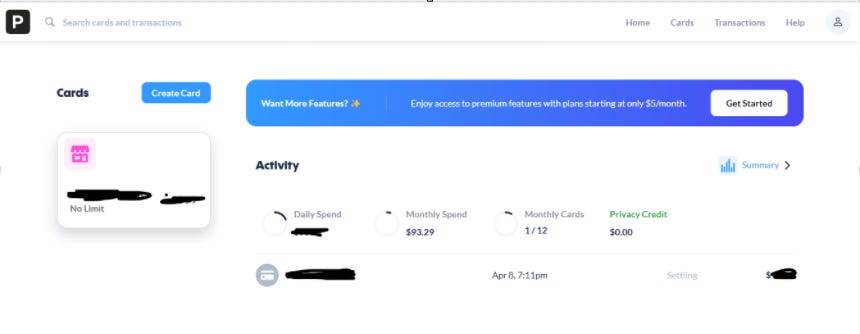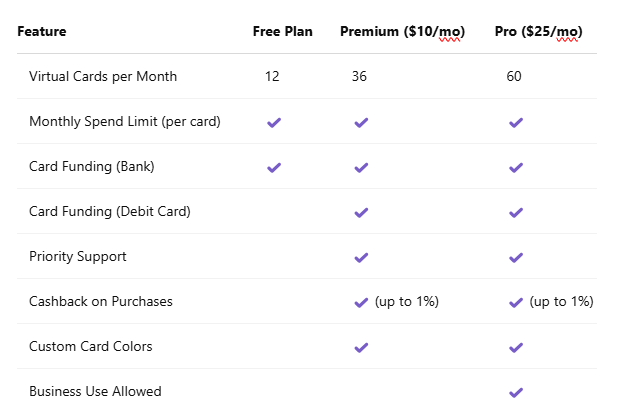There’s a Smarter, More Private Way to Pay Online (Here’s How)
Hide your real card number. Block shady charges. Take back control.
Imagine if every store you walked into made a copy of your house key. You’d be nervous handing that out, right? Yet that’s essentially what happens when you share your real payment card details online.
Every time you enter your actual card number, you’re putting your personal information and your money at risk (especially with a debit card).
Think: tracking, data leaks, unwanted charges, and subscription traps.
That’s where a service like Privacy.com comes in. It lets you generate virtual cards that keep your real banking info hidden from merchants.
You stay in control. You get peace of mind. And your wallet becomes a little safer.
As an added bonus, it’s a productivity upgrade. More on this later.
We recently created an account with Privacy.com and made some sample purchases. We weren’t asked to do this by Privacy.com or paid to do it in any way. Privacy.com has been on our radar for a while now and we finally go around to test driving it.
Let’s take a look at how it works, and how to get the most out of it.
What Is Privacy.com?
Privacy.com is a free tool that lets you generate virtual debit cards for online purchases. More accurately, it has a free tier along with paid tiers for enhanced features (more on that later). Instead of using your real bank card, you create a virtual card tied to your Privacy.com account. Each card has its own number, expiration date, and CVV, just like a regular debit or credit card.
With a Privacy.com account, you can:
Create single-use cards that deactivate after one transaction
Set spending limits on recurring cards
Pause or delete cards anytime
See exactly which merchant charged which card
Your real banking info is never exposed to merchants.
Privacy.com connects to your funding source, usually a checking account, and draws funds as you spend. It acts as a privacy shield between you and the merchants you pay.
Why It’s a Game-Changer for Privacy (and Sanity)
Let’s say you sign up for a “free trial” of an online service. You forget to cancel it, and boom, your account’s charged $49.99 every month. Or worse, you make a purchase from a compromised site, and your card number ends up on the dark web.
With Privacy.com, these problems vanish:
Use a single-use card for that free trial. It dies after one use.
Create a merchant-locked card for that subscription. If the vendor tries to charge you more than expected, or someone else tries to use it? Denied.
Set a $1 per month limit for that "free" service. If they try to sneak in a charge, it’ll get blocked, and you’ll get notified.
This isn’t just about protecting your data (though it will do that). It’s also about regaining control over your finances in a world that’s doing everything it can to nickel-and-dime you behind the scenes.
How It Works: Step-by-Step
Here’s how to get started:
1. Create Your Account
Go to privacy.com and sign up. You’ll need:
An email address
A U.S. bank account or debit card to link (they use encrypted Plaid or direct routing)
A phone number for two-factor authentication
2. Link Your Funding Source
Privacy.com pulls funds directly from your linked debit account. It doesn’t work with credit cards. We assume not using credit cards aligns with their goal of avoiding debt traps. There may also be an anti-fraud angle.
3. Generate a Virtual Card
From your dashboard, click “New Card” and customize:
Name: Call it “Spotify” or “Free Trial”
Limit: Set a dollar amount per transaction, per month, or total
Type: Choose whether the card is single-use or reusable
4. Use It Like a Normal Card
You’ll get a card number, expiration date, and CVV. Enter it wherever you’d normally pay online. Done.
Plan Comparison: Free vs. Paid Tiers
Privacy.com offers multiple tiers depending on your needs. Here's a breakdown:
Most people will be fine on the free tier. But if you run a business or want more control and support, the premium tiers are worth looking at.
Use Cases: Real-World Wins
Here are some powerful ways to use Privacy.com:
✅ Try-before-you-buy:
Want to test a new service? Use a single-use or $1-limited card. If it tries to auto-renew, it’ll fail.
✅ Subscription fireproofing:
Create separate virtual cards for each recurring bill: Netflix, Canva, Dropbox, etc. Pause them anytime.
✅ Stop leaks:
Privacy.com lets you track exactly where your money goes. No more "What is this $8.99 charge?"
✅ Teen spending:
Got kids using your debit card? Set them up with their own spending limit and cut it off when needed.
✅ One-off purchases:
Use a burner card for those "one-time" purchases from unknown vendors.
Combine It With a Disposable Email for Next-Level Privacy
Want to take things even further? Pair Privacy.com with a disposable or alias email address service like SimpleLogin or AnonAddy.
Instead of giving your real email address to every online store or subscription service, generate a new alias for each account. This way:
Your real email stays hidden
You can cut off spam by deactivating an alias
You de-anonymize fraud quickly by seeing where leaks originate
We even used a disposable email address to sign up for Privacy.com, which they permitted. Together, Privacy.com + disposable email aliases create a solid layer between your true identity and the internet.
Pros and Cons
Is Privacy.com right for you? Like any privacy tool, it comes with tradeoffs. Here’s a quick look at the biggest pros and cons to help you decide.
✅ Pros:
Free to use (up to 12 cards/month on the free plan)
Fast setup and intuitive dashboard
Total control over who charges you and how much
Works with most major retailers and services
Optional browser extension makes auto-fill easy (more on this below)
⚠️ Cons:
U.S. only (for now)
No credit cards as funding source (only debit/bank accounts)
Doesn’t work for in-person shopping unless the merchant allows manual card entry
Some banks may trigger fraud alerts the first time you link
Privacy.com is a centralized repository of your purchases, which is risky if they have a data breach or change their business model.
Ready to give Privacy.com a try? Use this affiliate link to sign up and make your first purchase.
Use the Browser Extension for Speed and Convenience
Privacy.com also offers a handy browser extension for Chrome, Brave, Firefox, and Edge. It makes creating and using virtual cards even faster:
Auto-fill cards at checkout so you don’t have to copy/paste
Generate new cards on the fly directly in your browser
Stay logged in for quick access to your dashboard
Identify saved merchant cards for reuse or editing
Why use it? Because convenience shouldn’t cost you privacy. With the extension, you don’t have to switch tabs or log into your dashboard every time you need a new card. It brings privacy right into your checkout flow when you need it.
Small Wins You Can Try Right Now
A benefit of Privacy.com is that small, consistent changes in your spending habits can quickly add up. Whether you’re testing a questionable site, signing up for a free trial, or just want to put a cap on impulse purchases, these quick privacy wins will immediately boost your privacy and your peace of mind.
Here are some sample use cases:
Keep reading with a 7-day free trial
Subscribe to Secrets of Privacy to keep reading this post and get 7 days of free access to the full post archives.




